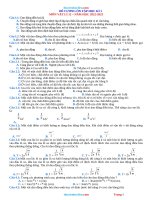ONT activation and Troubleshooting based on service model
Bạn đang xem bản rút gọn của tài liệu. Xem và tải ngay bản đầy đủ của tài liệu tại đây (3.01 MB, 53 trang )
ONT activation and
Troubleshooting based
on service model
Reference:
1. T-REC-G.984.3-01-2014.pdf
/>2. T-REC-G.984.4-200802-I!!PDF-E.pdf
/>3. T-REC-G.988-10-2012.pdf
/>4. gpon trainning.pptx
/>5. ONT debugging tips
/>
© 2017 DASAN Zhone Solutions – Proprietary and
Confidential
2
1. ONT activation method
GPON Element communication
© 2017 DASAN Zhone Solutions – Proprietary and Confidential
OMCC-OMCI channel establishmnet
© 2017 DASAN Zhone Solutions – Proprietary and Confidential
10.2.5.1 Downstream PLOAM Message
MT
Name
Function
1
Upstream_Overhead
Pre-assigned delay, the number of preamble bytes, ONU optical power
2
Assign_ONU-ID
Link a free ONU-ID with the serial number
3
Ranging_Time
equalization delay (in bits)
4
Deactivate_ONU-ID
instruct to stop sending upstream traffic and reset itself
5
Disable_Serial_Number
Disable / enable with this serial number
6
Encrypted_Port-ID
Indicate to ONUs which channels are encrypted or not
7
Request_Password
Request the password from an ONU in order to verify it
8
Assign_Alloc-ID
Instruct an ONU that the specified allocation ID is assigned to it
9
No Message
No message available when a PLOAM field is transmitted
10
POPUP
POPUP state Ranging State (O4) or Operation state (O5)
11
Request_Key
Trigger ONU to generate a new encryption key and send it upstream
12
Configure_Port-ID
Configure GEM Port for OMCI channel
13
Physical_Equipment_Error(PEE)
Indicate to the ONUs that the OLT is unable to send both GEM frames and OMCC frames
14
Change_Power_Level
The OLT triggers the ONU to either increase or decrease its transmitted power level
15
PST message
To check the ONU-OLT connectivity in a survivable PON configuration, and to perform APS
16
BER Interval
Accumulation interval per ONU for collecting bit errors
17
Key_Switching_Time
The OLT indicates to the ONU when to begin using the new encryption key
18
Extended_Burst_Length
Instruct the ONU the number of type 3 preamble bytes to use in the upstream direction
6
© 2017 DASAN Zhone Solutions – Proprietary and
Confidential
The “activation process” is performed under the control of the OLT by means of exchange of upstream
and downstream PLOAM messages
STEP1
The ONU entering the activation process listens to the downstream transmission and attains PSync and
superframe synchronization.
Parameter
Learning
STEP2
The ONU waits for the Upstream_Overhead PLOAM message optionally followed by the
Extended_Burst_Length PLAOM message periodically issued by the OLT
STEP3
The ONU receives the PON operating parameters through the Upstream_Overhead and
Extended_Burst_Length messages.
Serial
Number
Acquisition
STEP4
The ONU announces its presence on the PON by responding to a broadcast Serial Number request
periodically issued by the OLT with a Serial_Number_ONU message
STEP5
The ONU adjusts its transmission optical power level using the absence of directed messages from the
OLT as a negative acknowledgement
© 2017 DASAN Zhone Solutions – Proprietary and
Confidential
7
Serial
Number
Acquisition
STEP6
The OLT discovers the Serial Number of a newly connected ONU and assigns an ONU-ID to it using
the Assign_ONU-ID message
STEP7
The OLT issues a directed Serial Number request to a newly discovered ONU and accurately times the
ONU’s response
Ranging
STEP8
The OLT computes the individual Equalization Delay and communicates this Equalization Delay to the
ONU using the Ranging_Time message
STEP9
The ONU adjusts the start of its Upstream GTC Frame clock based on its assigned Equalization Delay.
STEP10
The ONU completes activation and start regular operation.
© 2017 DASAN Zhone Solutions – Proprietary and
Confidential
8
10.2.3 ONU state diagram
© 2017 DASAN Zhone Solutions – Proprietary and Confidential
9
I.1.4.1 Old ONU bring-up
Once the ONU enters operation state O5 after activation, the OLT creates the OMCC as described in clause B.1. As
described in clause I.1.3.1, the OLT then retrieves the ONU MIB data sync value by sending a get (ONU data (MIB data
sync)) message to the ONU. The OLT compares the received MIB data sync attribute value to the OLT's own MIB data
sync value for that ONU. The result of the comparison leads to three possible ONU bring-up scenarios:
If the ONU's MIB data sync value matches the OLT's value, and is not zero, the OLT may assume that their MIBs
are in alignment. The ONU bring-up process is complete.
NOTE – The OLT ultimately makes the choice between trusting MIB sync match – which is not a guarantee – and
resynchronizing the MIBs in detail. The OLT also has the choice to reset the MIB and rebuild it from scratch or to
audit and repair it incrementally
If the ONU's MIB data sync value equals zero, possibly the result of an ONU software upgrade or because the ONU
considers its MIB to be invalid, the OLT follows the bring-up sequence described for a new ONU
If the ONU's MIB data sync value does not match the OLT's value, the OLT executes the MIB synchronization
process, as described in clause I.1.3.2. Once the OLT has provisioned the ONU's MIB, it must align MIB data sync
values. The OLT completes the bring-up process by sending a set (ONU data (MIB data sync)) command.
I.1.4.2 New ONU bring-up
© 2017 DASAN Zhone Solutions – Proprietary and Confidential
OLT sets the ONU MIB to its default state by
sending a MIB reset to the ONU. The ONU reinitializes its MIB to the default and resets the
MIB data sync attribute to zero.
Next, the OLT uploads the ONU's MIB to
retrieve all ME instances and capabilities. The
OLT then issues create, delete and set
commands to bring the ONU's MIB into sync
with the OLT's MIB.
When an ONU changes an attribute value
autonomously, it sends an attribute value
change message (AVC) to the OLT. The ONU
can send AVCs during the MIB
synchronization or MIB download processes.
AVCs should be viewed as a partial method of
ONU state discovery. Not all managed Rec.
ITU-T G.988 (10/2012) 521 entities or
attributes issue AVCs, and an AVC message can
be lost in transmission without an error being
detected. Therefore, the OLT should audit the
ONU state immediately after a reset has been
completed.
New ONU bring-up (Cont)
Apply traffic profile
Apply traffic profile
© 2017 DASAN Zhone Solutions – Proprietary and
15
Confidential
2. OMCI Key Components
1.
2.
Transaction correlation identifier
Associate a request message with its response message
The transaction identifier of event messages is 0x0000
Most significant bit of TID indicates the priority
Normally almost message’s priority is high
Message type
DB always 0 (reserved)
AR indicates whether or not the message requires an acknowledgment
AK indicates whether or not this message is an acknowledgement to an action request
MT indicate the message type. (0 ~ 31): Table 11.2.2-1
‒ 4 : create
‒ 6 : delete
© 2017 DASAN Zhone Solutions – Proprietary and Confidential
‒ 8 : set
3.
4.
Device identifier
Message identifier
•
•
5.
ME class
: 2 byte
ME Instance : 2 byte
Message contents
•
6.
Defined as 0x0A
Maximum length is 32 bytes
OMCI tailer
•
•
•
First 2 bytes are set to 0x0000
Next 2 bytes are 0x0028
Last 4 bytes are 32-bit CRC
© 2017 DASAN Zhone Solutions – Proprietary and
Confidential
17
Example
0000
0010
0020
0030
00 00 00 00 00 01 00 00 00 00 00 02 88 b5 80 27
44 0a 00 2d 00 01 00 01 01 00 00 06 00 01 00 04
00 00 00 00 00 00 00 00 00 00 00 00 00 00 00 00
00 00 00 00 00 00 00 00 00 28 00 00
© 2017 DASAN Zhone Solutions – Proprietary and
Confidential
18
Management Entity
Relationships
Attributes
Actions
Notifications
© 2017 DASAN Zhone Solutions – Proprietary and
Confidential
19
Relationships
© 2017 DASAN Zhone Solutions – Proprietary and
Confidential
20









